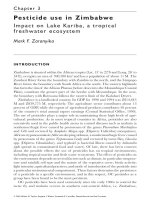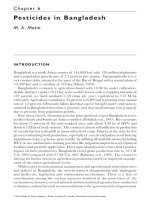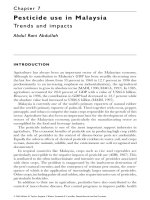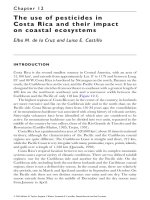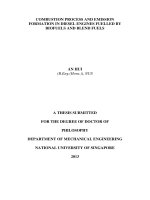Excellence in business communication 12e by vthill and brovee chapter 03
Bạn đang xem bản rút gọn của tài liệu. Xem và tải ngay bản đầy đủ của tài liệu tại đây (885.24 KB, 32 trang )
Copyright © 2017 Pearson Education, Inc.
Excellence in
in
Excellence
Business Communication
Communication
Business
Chapter 3
Communication Challenges in a Diverse, Global
Marketplace
Copyright © 2017 Pearson Education, Inc.
Learning Objectives
1.
(1 of 2)
Discuss the opportunities and challenges of intercultural
communication.
2.
Define culture, explain how culture is learned, and define
ethnocentrism and stereotyping.
3.
Explain the importance of recognizing cultural variations,
and list eight categories of cultural differences.
Copyright © 2017 Pearson Education, Inc.
Chapter 3 - 3
Learning Objectives
4.
(2 of 2)
List four general guidelines for adapting to any business
culture.
5.
Identify seven steps you can take to improve your
intercultural communication skills.
Copyright © 2017 Pearson Education, Inc.
Chapter 3 - 4
Communicating in
in a
a
Communicating
Diverse World
World
Diverse
(LO 1) Discuss the opportunities and challenges of intercultural
communication.
Copyright © 2017 Pearson Education, Inc.
Chapter 3 - 5
Advantages of a
Diverse Workforce
Copyright © 2017 Pearson Education, Inc.
Chapter 3 - 6
Challenges of Intercultural
Communication
Copyright © 2017 Pearson Education, Inc.
Chapter 3 - 7
Developing Cultural
Cultural Competency
Competency
Developing
(LO 2) Define culture, explain how culture is learned, and define
ethnocentrism and stereotyping.
Copyright © 2017 Pearson Education, Inc.
Chapter 3 - 8
Culture
•
Culture
– Shared system of symbols, beliefs, attitudes, values,
expectations, and behavior norms
•
Learning Culture
– Directly - > Through Instruction
– Indirectly - > Observing Others
Copyright © 2017 Pearson Education, Inc.
Chapter 3 - 9
Challenges of a
Diverse Workforce
Understanding the
Effects of Culture
Copyright © 2017 Pearson Education, Inc.
Developing Cultural
Competency
Chapter 3 - 10
Ethnocentrism & Stereotyping
•
Ethnocentrism
– Tendency to judge all other groups according to the standards,
behaviors, and customs of one’s own group
•
Stereotyping
– Assigning generalized attributes to an individual on the basis of
membership in a particular group
Copyright © 2017 Pearson Education, Inc.
Chapter 3 - 11
Recognizing Variations
Variations in
in aa
Recognizing
Diverse World
World
Diverse
(LO 3) Explain the importance of recognizing cultural variations,
and list eight categories of cultural differences.
Copyright © 2017 Pearson Education, Inc.
Chapter 3 - 12
Cultural Context
More
Less
Circumstances
Message Content
Low-Context Culture
High-Context Culture
Less
Copyright © 2017 Pearson Education, Inc.
More
Chapter 3 - 13
Key Aspects of
Cultural Diversity
Cultural Context
Age Differences
Legal and Ethical
Gender Differences
Social Customs
Religious Differences
Nonverbal Signals
Ability Differences
Copyright © 2017 Pearson Education, Inc.
Chapter 3 - 14
Legal and Ethical Differences
Seek
SeekMutual
Mutual
Ground
Ground
Withhold
WithholdJudgment
Judgment
Send
SendHonest
Honest
Respect
RespectCultural
Cultural
Messages
Messages
Differences
Differences
Copyright © 2017 Pearson Education, Inc.
Chapter 3 - 15
Social Customs
Etiquette and Manners
Formal Rules
Informal Rules
Attitudes toward Time
Individualism vs. Collectivism
Attitudes toward Status or Wealth
Respect for Authority
Copyright © 2017 Pearson Education, Inc.
Chapter 3 - 16
Nonverbal Communication
Communication Process
Decoding
Interpreting
Messages
Messages
Cultural Context
Copyright © 2017 Pearson Education, Inc.
Chapter 3 - 17
Age Differences
Culturesthat
thatValue
ValueYouth
Youth
Cultures
Culturesthat
thatValue
ValueSeniority
Seniority
Cultures
Cultureswith
withMultiple
MultipleGenerations
Generations
Cultures
Copyright © 2017 Pearson Education, Inc.
Chapter 3 - 18
Gender Differences
PerceptionofofMen
Menand
andWomen
Women
Perception
PercentageofofManagement
ManagementRoles
Roles
Percentage
DifferentCommunication
CommunicationStyles
Styles
Different
Copyright © 2017 Pearson Education, Inc.
Chapter 3 - 19
Religious Differences
Personal
Personal
Workplace
Workplace
Beliefs
Beliefs
Issues
Issues
Copyright © 2017 Pearson Education, Inc.
Chapter 3 - 20
Ability Differences
Respect for Individuals
Sensitivity to Differences
Use of Assistive Technologies
Copyright © 2017 Pearson Education, Inc.
Chapter 3 - 21
Adapting to
to Other
Other Business
Business Cultures
Cultures
Adapting
(LO 4) List four general guidelines for adapting to any business
culture.
Copyright © 2017 Pearson Education, Inc.
Chapter 3 - 22
Guidelines for Adapting to Any Business
Culture
•
•
•
•
Be Aware of Your Own Biases
Use Caution Applying the “Golden Rule”
Practice Tolerance, Flexibility, and Respect
Practice Patience and Maintain a Sense of Humor
Copyright © 2017 Pearson Education, Inc.
Chapter 3 - 23
Guidelines for Adapting to U.S.
Business Culture
•
•
•
•
•
•
Individualism
Equality
Privacy and Personal Space
Time and Schedules
Religion
Communication Style
Copyright © 2017 Pearson Education, Inc.
Chapter 3 - 24
Improving Intercultural
Intercultural Communication
Communication Skills
Skills
Improving
(LO 5) Identify seven steps you can take to improve your
intercultural communication skills.
Copyright © 2017 Pearson Education, Inc.
Chapter 3 - 25


